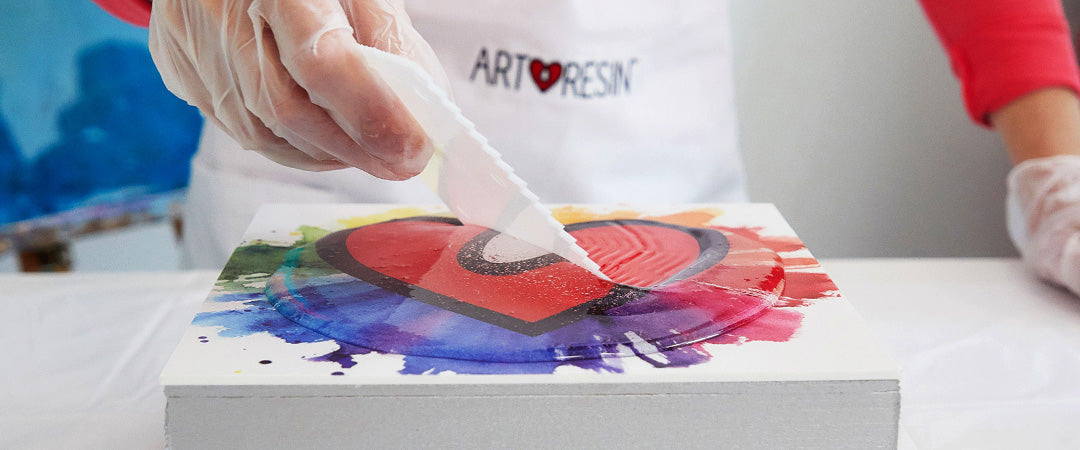
It can be used to cover and protect artwork and photos, or to sculpt and make jewelry. Thanks to its UV protection, anti-yellowing stabilizer and non-toxic composition, this quality resin will respect and preserve your works of art for decades.
Find answers to 7 frequently asked questions about resin. Written by Pascale Simard – Store Manager (DeSerres Galeries de la Capitale and DeSerres Hamel) & ArtResin Specialist
1. Is ArtResin safe? Is it suitable for food use?
Once cured, ArtResin is safe for direct food contact. For example, it can be used on plates, mugs, etc. However, it’s best not to apply it on areas that often come into contact with utensils, as this could damage the resin over time.
2. Bubbles appeared in my resin. Why does this happen and how do I remove them?
Bubbles often appear during stirring; this is a perfectly normal phenomenon that occurs when oxygen particles enter the mixture. ArtResin has a component that brings bubbles to the surface so they can burst and disappear, but you can completely eliminate bubbles with an embosser to obtain an ultra-clear finish.For best results, use the ArtResin butane torch to burn off any hair or dust particles that may have settled on your project before the resin hardened. Make sure to protect your artwork during the drying process!

3. My resin has an opaque finish. Why and how do I avoid it?
Matte or semi-opaque finishes often arise from the use of plastic moulds. It’s best to use silicone moulds to avoid this problem. To restore some shine, use a brush to apply a matte-finish resin topcoat over the project. However, if the hardened layer is really opaque, it will be impossible to obtain the desired transparency.You should then verify if the problem is caused by air bubbles that formed in the mixture before hardening. This phenomenon is amplified if the resin is cold (<23–25°C) before mixing. You can submerge the tightly closed bottles (resin and hardener) in hot water for 10 minutes before mixing, but this will reduce working time by 10 to 15 minutes, the latter being initially 45 minutes.
4. My resin is sticky. Why and how do I fix it?
ArtResin should be mixed with equal parts of resin and hardener. If the proportions (50%/50%) aren’t respected, or if the two aren’t mixed well enough to obtain a homogeneous mixture, the final mixture won’t harden properly and will remain sticky.To fix this, you can sand the sticky surface, wipe it with a damp cloth and pour a new layer of resin over the first one, making sure that the resin is perfectly homogeneous and mixed equally this time.

5. How much resin do I need to cover my painting?
On a flat surface, ArtResin will automatically level to a thickness of 1/8". The ArtResin website has a calculator that provides all the information you need to estimate the amount of resin required for your project.Click here >
6. Why are there bare spots in my cured resin?
Most commonly, bare spots appear when the surface is still oily or wet. Although ArtResin is versatile and can be applied to many water or oil-based surfaces, the final layer must be dry and non-oily. Bare spots are common when resin is applied over acrylic pour painting projects; silicone oil is often used with this technique and it doesn't dry completely.To prevent this from happening, it’s best to wait until the paint layer is dry, then carefully clean the surface with a soft, damp cloth and a little degreaser (ex: Dawn dish soap). Make sure to remove any soap residue before pouring the resin. If, despite these precautions, bare spots still appear after drying, you can use 80-grit sandpaper to sand down the surface. Then wipe and pour more mixed resin into the hole.

7. Does resin turn yellow?
Unfortunately, all resins end up yellowing over time; however, ArtResin is made with museum-grade conversation products to ensure a clear, transparent finish that will last several decades. Unlike most resins that contain only a UV stabilizer to help delay yellowing, ArtResin also contains an advanced additive called HALS (Hindered Amine Light Stabilizer) that controls the yellowing process before it begins.
Several environmental factors can contribute to yellowing, such as lighting, temperature, etc. Use a torch sparingly, as the powerful heat can contribute to yellowing.
Still have questions? Check out the FAQ on ArtResin.com
Shop ARTRESIN >


